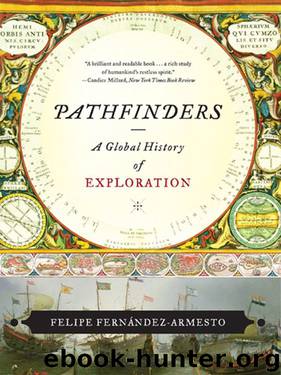Pathfinders: A Global History of Exploration by Felipe Fernández-Armesto

Author:Felipe Fernández-Armesto [Fernández-Armesto, Felipe]
Language: eng
Format: epub
Publisher: W. W. Norton & Company
Published: 2007-10-16T21:00:00+00:00
Juan Vespucci’s Planisphere, 1526, detail. The map exemplifies, and perhaps fortified, belief in a narrow New World and a passage through it from the northwest Atlantic
Verrazano discovered, by his own account, ‘a new land, never before seen by anyone, ancient or modern’—implicitly excepting the people who lived there. The land blocked the site of the expected passage to Asia. He tried to make up for the disappointment by some rather unconvincing promotional writing. The land was ‘adorned and clothed’ with useful trees. It ‘partook of the nature of the Orient.’ It was full of hospitable people, at least at intervals. It looked as if it had gold, ‘to which land of such appearance has every disposition.’ It was full of game. Verrazano established the existence of a continuous coastline. He also initiated a new myth: that North America was a narrow continent and that the Pacific lapped it, at its closest point, only a short way from the eastern shore of the continent. Rounding Cape Lookout, he claimed to be off an isthmus only a mile wide, ‘where from the ship we could see the Oriental Sea . . . which, no doubt, surrounds the shores of India, China and Cathay.’ Presumably, the shallow islets of the Carolina Outer Banks deluded him.33
Meanwhile, the king of Spain sent an expedition under yet another Portuguese renegade, Estevão Gomes, who had accompanied and deserted Magellan, to ‘go and explore eastern Cathay as far as our island of Maluco.’ Gomes reported no way through between Cape Breton and Florida, which was well known, about as far north as Cape Fear, from Ponce’s efforts and those of failed colonizing ventures that followed in his wake.
The only remaining prospect of a short sea route from Europe to Asia now lay in the far north, through the abominable hazards of icy Arctic waters. In the years after John Cabot’s voyages,34 Portuguese reconnaissances of the coasts of Labrador, Newfoundland, and, perhaps, Nova Scotia had impressed mapmakers, but not backers of further voyages, except in England, which was the realm best placed for access to these bleak lands and deceptive waters. Robert Thorne, merchant of Bristol, whose father had been among John Cabot’s financiers, made the point in a petition he addressed to Henry VIII of England in 1527. To reconnoiter the ‘north parts . . . is only your charge and duty.’ Thorne subscribed to a theory widely espoused at the time and inherited from late medieval geographers: that the Arctic Ocean was navigable and traversable via the North Pole. One of the sources cited by sixteenth-century cartographers in support of the theory was the now lost work of a fourteenth-century English friar, recounting his voyages to the Pole.35 This was an unfortunate basis on which to begin the task of Arctic exploration. John Rut, sent to put the theory to the test in 1527, turned back at about the fifty-third parallel for fear of ice.
The English assault on the Northwest Passage began in earnest only in the 1570s, when English envy of Spain and Portugal became acute.
Download
This site does not store any files on its server. We only index and link to content provided by other sites. Please contact the content providers to delete copyright contents if any and email us, we'll remove relevant links or contents immediately.
Autoboyography by Christina Lauren(4690)
Asking the Right Questions: A Guide to Critical Thinking by M. Neil Browne & Stuart M. Keeley(4615)
Dialogue by Robert McKee(3601)
Eat That Frog! by Brian Tracy(3541)
Sticky Fingers by Joe Hagan(3463)
Journeys Out of the Body by Robert Monroe(3010)
Elements of Style 2017 by Richard De A'Morelli(2951)
Annapurna by Maurice Herzog(2855)
Schaum's Quick Guide to Writing Great Short Stories by Margaret Lucke(2818)
Full Circle by Michael Palin(2790)
The Diviners by Libba Bray(2454)
The Art of Dramatic Writing: Its Basis in the Creative Interpretation of Human Motives by Egri Lajos(2424)
The Mental Game of Writing: How to Overcome Obstacles, Stay Creative and Productive, and Free Your Mind for Success by James Scott Bell(2403)
Why I Write by George Orwell(2373)
Atlas Obscura by Joshua Foer(2358)
In Patagonia by Bruce Chatwin(2282)
The Fight by Norman Mailer(2165)
The Elements of Style by William Strunk and E. B. White(2080)
Venice by Jan Morris(2060)
